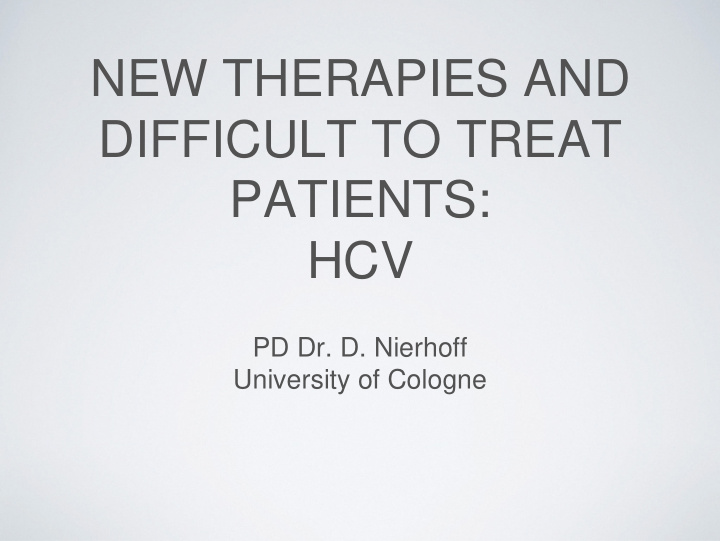



NEW THERAPIES AND DIFFICULT TO TREAT PATIENTS: HCV PD Dr. D. Nierhoff University of Cologne
NEW
NEW SINCE AREVIR MEETING 2017
NEW THERAPIES (SINCE AREVIR MEETING 2017) • Maviret • Vosevi
NEW THERAPIES (SINCE AREVIR MEETING 2017) • Maviret pangenotypic, first line • Vosevi
NEW THERAPIES (SINCE AREVIR MEETING 2017) New Old ( ) Harvoni, Zepatier GT 1&4, first line • Maviret Epclusa pangenotypic, first line • Vosevi
NEW THERAPIES (SINCE AREVIR MEETING 2017) Old ( ) Harvoni, Zepatier GT 1&4, first line • Maviret Epclusa pangenotypic, first line • Vosevi pangenotypic, second line
REAL WORLD WITH PANGENOTYPIC THERAPIES
REAL-WORLD WITH GP
REAL-WORLD WITH GP
REAL WORLD WITH SV
REAL-WORLD WITH SVV
DIFFICULT TO TREAT PATIENTS? Choice of best treatment Time point of treatment Caution during treatment No licensed treatment
DIFFICULT TO TREAT PATIENTS? Choice of best treatment • Relapser • Genotype 3 and LCI
DIFFICULT TO TREAT PATIENTS? Choice of best treatment • Relapser Only Vosevi available! • Genotype 3 and LCI
ASTRAL-3 OPEN-LABEL TRIAL: SVR12, SAFETY WITH SOFOSBUVIR/VELPATASVIR IN GT3 HCV SOF/VEL 12 wks P < .001 SOF + RBV 24 wks (superiority) 97 97 95 91 90 100 87 86 80 66 63 80 SVR12 (%) 60 40 20 264/2 221/2 191/1 163/1 73/ 55/ 200/ 176/ 64/ 45/ n/N = 77 75 97 87 80 83 206 204 71 71 0 Experienced All Pts No Yes Naive Cirrhosis Treatment History Mangia A, et al. AASLD 2015. Abstract 249. Reproduced with permission. Slide credit: clinicaloptions.com Foster GR, et al. N Engl J Med. 2015;[Epub ahead of print].
NEW EASL GUIDELINE 2018
GT3 WITH LCI SOF/VEL +/- RBV
GT3 WITH LCI SOF/VEL +/- RBV
GT3 WITH LCI SOF/VEL +/- RBV
IF A PROBLEM WITH RBV …
WITH REGARD TO PRICE … Price (AVP) SV 12 W + RBV 34.957,44 + ca. 2.000 GP 12 (naive)- 16 W 52.436,16 - 69.914,88 (experienced) (KI for RBV) SVV 8W 44.521,76 (second line)
DIFFICULT TO TREAT PATIENTS? Choice of best treatment • Relapser • Genotype 3 and LCI 2 options and a backup: Just a matter of price or RBV.
DIFFICULT TO TREAT PATIENTS? Time point of therapy • Decompensated liver cirrhosis • Patients with HCC
Waiting list for liver Tx 2008 2009 2010 2011 2012 2013 2014 2015 2016 2017 Germany 1948 2163 2161 2119 1868 1534 1351 1280 1157 1086
INCIDENCE OF NEW HCC No evidence for differential occurrence of HCC following SVR from DAA and IF.-based therapy. Waziry et al., J Hepatol 2017
RECURRENT HCC No evidence for differential recurrence of HCC following SVR from DAA and IF.-based therapy. Waziry et al., J Hepatol 2017
DIFFICULT TO TREAT PATIENTS? Time point of therapy • Decompensated liver cirrhosis Rare • Patients with HCC Probably no harm to treat these patients, but maybe not helpful, if no LTx option.
DIFFICULT TO TREAT PATIENTS? Caution during treatment • HBV • Chronic kidney injury
Reaktivierung von Anti-HBc only unter DAA-Therapie!
DIFFICULT TO TREAT PATIENTS? Caution during treatment If problems exists, it is rare. • HBV Check viral load during therapy. • CKI
SOF-BASED DAA WITHOUT IFN IS A RISK FACTOR FOR EGFR DECREASE: GIVE WITH CAUTION AMONG PATIENTS AT RISK OF RENAL PROGRESSION • Linear mixed model of eGFR variations in a 2013–2016 monocentric retrospective observational cohort of 814 CHC patients • Median (IQR) age: 58 (52–66) years; 40% cirrhosis; 25% CKD risk factors eGFR variations among 740 CHC patients exposed to eGFR variations among 74 CHC patients exposed to SOF-based DAA treatment non-SOF-based DAA treatment Without CKD risk factors With CKD risk factors 96 97 REF p=0.225 p=0.124 p=0.11 Mean (95% CI) eGFR, ml/min/1.73 m 2 Mean (95% CI) eGFR, ml/min/1.73 m 2 p=0.582 94 REF p=0.122 92 p<0.001 92 87 90 88 82 p<0.001 86 p=0.663 p=0.745 77 REF REF p=0. 945 84 p=0.735 p=0.014 82 72 Before DAA At DAA Under DAA After DAA Before DAA At DAA Under DAA After DAA (n=74; 73 (n=41; 100 (n=740; 740 (n=64; 59 (n=46; 71 (n=421; 1,266 (n=640; 929 (n=503; 1,040 measures) measures) measures) measures) measures) measures) measures) measures) Median (IQR): 107 (340) wks Median (IQR): 24 (17) wks Median (IQR): 92 (204) wks Median (IQR): 23 (12) wks Linear mixed models of eGFR were stratified by CKD risk factors with SOF exposure as a fixed factor and with adjustments for baseline patient demographics and clinical characteristics Mallet V, et al. ILC 2018, #PS-037
DIFFICULT TO TREAT PATIENTS? Caution during treatment If problems exists, it is rare. • HBV Check viral load during therapy. If problems exists, it is mild. • CNI Check GFR during therapy.
DIFFICULT TO TREAT PATIENTS? No licensed treatment • Children < 12 years • Acute hepatitis C
DIFFICULT TO TREAT PATIENTS? No licensed treatment • Children < 12 years • Acute hepatitis C
DIFFICULT TO TREAT PATIENTS Choice of best treatment Time point of treatment rare Relapser Decomp. LCI no GT 3 and LCI Patients with HCC harm Caution during No licensed treatment treatment HBV Children < 12y check CKI Acute hepatitis
SUMMARY THE NEW STUFF IS NO LONGER NEW, AND THE DIFFICULT PATIENTS ARE NO LONGER DIFFICULT OR AT LEAST RARE!
THANK YOU VERY MUCH FOR YOUR ATTENTION
Recommend
More recommend